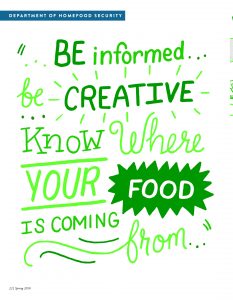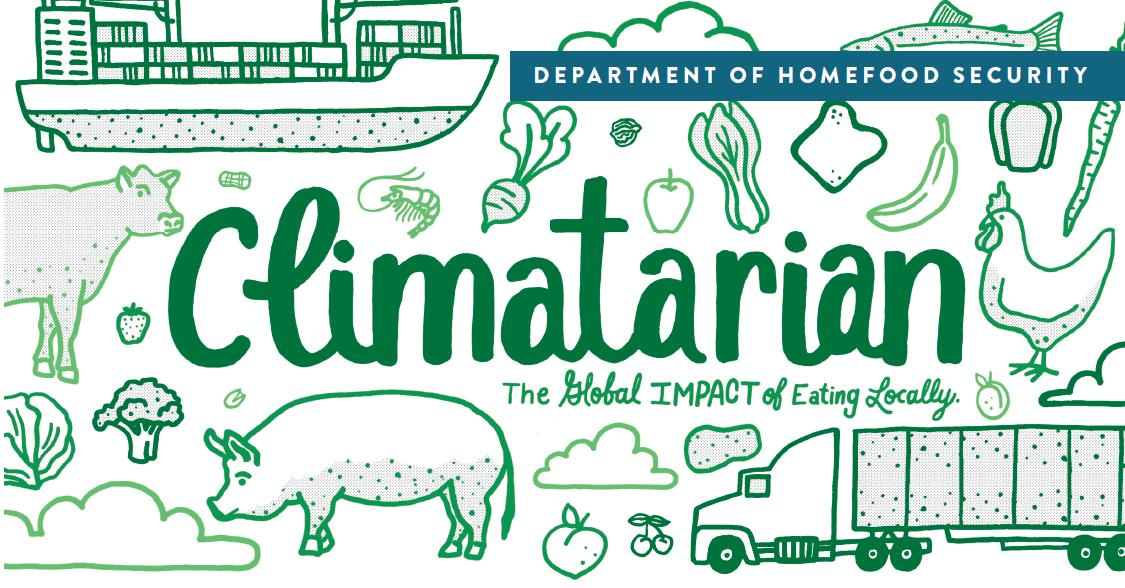The Global Impact of Eating Locally
/By Sara Axelrod, Illustrated by Gavin Roarke. This article originally appeared in our Spring 2016 Issue.
CLIMATARIAN (n.)—A person whose primary diet goal is to reverse climate change. This includes eating locally produced food (to reduce energy spent in transportation), choosing pork and poultry instead of beef and lamb (to limit gas emissions) and using every part of each ingredient (apple cores, cheese rinds, etc.) to limit food waste.
Flexitarians, pescetarians, vegetarians, vegans, paleos and omnivores—make room. 2015 was the year that eating to help prevent climate change got a name: climatarian.
Late last year, The New York Times coined the term “climatarian” to describe a socially conscious diet that would lower environmental impact. However, in the world of organic, local, GMO-free, antibiotic-free, eating a healthy and sustainable diet seems dauntingly complex.
As I peruse the farm markets and grocery aisles, I wondered: “How do we know what the best choices are to lessen our impact on our planet?”
Some things that would help would be eating local food that doesn’t travel far. And choosing food that is grown organically or sustainably, without pesticides and fertilizers and with water and soil conserving methods. A serious goal would be eating less pastured meat, since meat production takes a lot of land and energy to raise and transport. Even more concerning are the greenhouse gases that livestock produce.
Zeke Zechiel of Washington Green Grocer—a subscription-based produce delivery service that aggregates the produce from many local area farms—has spent his career asking this question. When he and his wife started Washington Green Grocer 25 years ago, he says their original goal was to “get better food to people.” Over time, as consumer attitudes have evolved, so has Washington Green Grocer. They now offer a “local only” box for under $35, allowing their customers to eat seasonally and locally. Zechiel believes the most important thing we can do is “buy small and buy local.” By strengthening and diversifying our local food sources we can ultimately reduce the impact of food on climate change on a global scale.
Chef Jeremiah Langhorne of the recently launched restaurant The Dabney agrees. “When we buy seasonally and support a small chicken producer or a guy who is picking black walnuts, we create a market for the product and allow their business to grow,” says Langhorne. “Then in the future more people will have access to an underdeveloped product such as the black walnuts or sustainably raised chickens. This way of sourcing also allows us to cut down on our carbon footprint and helps lessen environmental impact.”
Langhorne feels that his mantra “eat seasonally and locally” is fundamental to The Dabney’s success—a story not unlike that of his mentor Sean Brock, the critically acclaimed chef of Charleston-based Husk and McGrady’s, where Langhorne cultivated his love for local ingredients. Brock kick-started an extreme local movement in the South with widespread implications. When asked if Langhorne hopes to have the same impact here in DC, a policy hub where he could potentially influence more than the food sector, he said, “Yes, whenever you can get people to think more about food and what they’re putting in their bodies, it’s a good thing. The more we support local producers, the more affordable and accessible the products will become.”
Some restaurants in DC have taken this methodology to heart, not only supporting local producers, but taking over the production themselves. Rappahannock Oyster Company, whose Rappahannock Oyster Bar at Union Market has become a favorite spot for local seafood, has taken an active role in helping to repopulate the native Chesapeake Bay oyster—after pollution, sea level rise and overfishing decimated the original population. A little more than a decade later, Virginia is seeing record harvest tallies, leading the East Coast in oyster production and most importantly, is doing so sustainably. And it’s a win-win, since a single oyster can filter 25-50 gallons of water a day.
Rappahannock Oyster Bar Manager Jean Paul Sabatier recommends that above all else, one needs “to be informed, and to be creative. Know where your food is coming from,” Sabatier says. “Be open to a vegetable, an herb or a protein that you haven’t tried before. Local ingredients might not be what you expect, but they are almost certainly more exciting than you think.” While climate change’s effects may impact us every day, time will tell whether we’ll see a term like “climatarian” take hold in our foodie vocabulary. However, the conscious choices we make about what we eat can make an impact: Eating local, wasting less and being aware and asking where our food is coming from and how it is produced.
 Hawaii/Colorado native and DC transplant, Sara Axelrod is a frequenter of farmers markets, vegetable enthusiast and constantly lusts after the perfect French fry. When she is not cooking or exploring DC’s thriving restaurant scene, she works at the DC-based public affairs firm, The Glover Park Group, as a communications professional on the Energy and Sustainability team, with a focus on food policy and sustainable agriculture.
Hawaii/Colorado native and DC transplant, Sara Axelrod is a frequenter of farmers markets, vegetable enthusiast and constantly lusts after the perfect French fry. When she is not cooking or exploring DC’s thriving restaurant scene, she works at the DC-based public affairs firm, The Glover Park Group, as a communications professional on the Energy and Sustainability team, with a focus on food policy and sustainable agriculture.
 Gavin Roarke is a Baltimore-based graphic designer, illustrator and frequent contributor to Edible DC, including the cover of Fall 2015. You can see his portfolio at http://cargocollective.com/gavinroarke.
Gavin Roarke is a Baltimore-based graphic designer, illustrator and frequent contributor to Edible DC, including the cover of Fall 2015. You can see his portfolio at http://cargocollective.com/gavinroarke.



